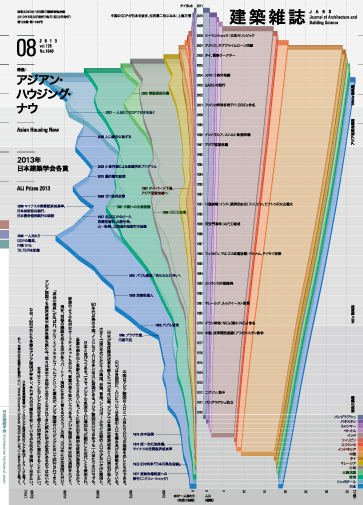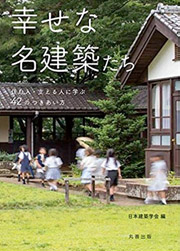本文PDFの閲覧につきましては、こちらでご確認ください。

2013-8月号 AUGUST
特集= アジアン・ハウジング・ナウ
Asian Housing Now
特集前言 70年代と現在の間:私たちは居住の不安定をどう生きるか
アジアのハウジングと言えば、1980年代前半までは同時代の状況がそれなりに日本にも伝えられていた。例えば、スラム改善という言葉で私たちが思い浮かべるイメージは、クリアランス+パブリック・ハウジングに代わって登場した、サイト・アンド・サービスなどのセルフエイド型のハウジングである。それは技術であり、思想であり、同時に政治でもあったろう。しかし、こうした潮流のその後を私たちはよく知らない。各国のハウジングは今どんな状況に直面し、政府の政策と専門家の活動は今どのような局面を迎えているのか。
この間、中国やASEAN諸国では経済成長と都市人口の増大が著しく、突出した富裕層とともに中間層も成長しているが、貧困層も拡大している。日本およびNIES諸国では停滞する経済と苦しい国家財政の下で非正規雇用者や単身高齢者が増え、総中流社会の幻想は崩壊しつつある。こうした変化の下で、アジアン・ハウジングの課題が変わらないないはずはない。言うまでもなく、いわゆるスラムだけが問題ではなく、ハウジングの課題領域はむしろ広がっている。
そして今や、日本にとってアジアン・ハウジングは、先進国の高みから臨み下ろすようなものではなくなった。むしろ、グローバルな同時性と、個別の軌跡の差異や捻れを前提にしつつ、「居住の不安定」を生きる者同士として、互いの「経験した過去」から「予測される未来」までを真摯に学びあうパートナーでありうる時代を迎えているのではないか。気候の変化、頻発する災害をも視野に入れるとき、この問いはなおさら切実に響くように思える。
第1部「アジアン・ハウジングの50年」では、城所哲夫氏が貧困層向け施策の観点から、また、水内俊雄氏が脱ホームレス支援の観点から、それぞれ過去半世紀のハウジング状況の軌跡を振り返り、近年の傾向を位置付けている。80 ~ 90年代以降、途上国の貧困層向けハウジングにおいても民活導入路線、すなわち新自由主義的な政策が浸透していること、一方、東アジアの経済先進地域では1990年代後半以降に同時並行的に居住の不安定化が生じていることが明晰に整理されている。
第2部は、「アジアン・ハウジングのリアリティ」と題する座談会である。穂坂光彦氏、ホルヘ・アンソレーナ氏は、1970年代からスラム改善を中心にアジアのハウジング・イシューの前線に立ってこられ、われわれにとってこの分野への数少ない導きとなる著者であるのみならず、現在も最も広くアジアン・ハウジングの現場に通暁する。西沢大良氏は、近代建築・近代都市計画の軌跡を、スラムを起点に据えてとらえ直す大きな歴史的パースペクティブから、建築家の職能を問う。資本の絶え間ない運動が空間を包摂し、政府がその管理者・支援者となる趨勢のなかで、居住の意味とそれを守るストラグルはどう変容しつつあるのか。多角的な検討の眼差しが交わる。
第3部は、アジア各地からの寄稿で構成している。インド人建築家にして40年以上にわたり主として南アジア地域で貧困層や周縁的社会層のハウジングに携わってきたK. Shahの書き下ろし論文、ならびにタイ、フィリピンでのコミュニティ・アーキテクトとしての実践とそのネットワーキングに尽力してきたチャワナッド・ルアンサン、スパウット・ブーンマハタナコン、マリア・ルード・ドミンゴ・プライスの論考("Environment & Urbanization"誌掲載論文の抄録転載)は、理念と実践をつなぐ座標を与えてくれる。パタマ・ルーンラクウィットは、バンコクにおいて、貧困層向けの政策が成果を上げる一方で、むしろいわば「インフォーマルな居住の貧困」に甘んじざるをえないミンドルインカム層への注意を喚起する。全泓奎はグローバル経済の進展のなかでますます顕在化する韓国ソウルの居住困窮層の新たな様相を詳しくレポートし、林文潔は中国における近年の住宅面積の拡大と価格高騰の現状、そして、途についたばかりの高齢者住宅政策の現況と今後の課題を紹介している。
これら海外からの貴重な寄稿の間に、本号編集担当者が5月末に訪れたCommunity Architects Networkの経験交流で得た情報をもとに作成した資料「アジアン・ハウジングとYoung Professionalの挑戦」を掲載した。
会誌編集委員会
本号編集担当:寺川政司(近畿大学)・初田香成(東京大学)
[目次]
| 000 | 連載 再建への意志:図面のなかの都市復興 シカゴ大火前の大改造─路面上昇に伴う建物のジャッキアップと曳家/鈴木真歩 |
| 002 | 連載 東日本大震災|連続ルポ1|動き出す被災地 防災集団移転のためのコミュニティ環境形成─宮城県気仙沼市片浜・古谷舘地区を事例に/脇田祥尚 |
| 004 | 連載 東日本大震災|連続ルポ2|仮すまいの姿 支援者から生活者へ─被災地への移住者の現在/渡邊享子 |
特集 アジアン・ハウジング・ナウ
| 006 | 特集前言 70年代と現在の間:私たちは居住の不安定をどう生きるか |
第1部 アジアン・ハウジングの50年
| 008 | アジア経済・政策、都市の変容とハウジング/城所哲夫 |
| 011 | 脱ホームレス支援からみたアジアンハウジングの最先端/水内俊雄 |
第2部 アジアン・ハウジングのリアリティ
| 014 | 座談会 西沢大良 × 穂坂光彦 × ホルへ・アンソレーナ |
第3部 アジアン・ハウジング・ナウ
| 022 | 人々による住宅:南アジアにおける貧困層のための挑戦課題/キルティ・シャー |
| 026 | スラム改善のためのコミュニティ・アーキテクトの役割:アジアの経験/チャワナッド・ルアンサン+スパウット・ブーンマハタナコン+マリア・ルード・ドミンゴ・プライス |
| 030 | アジアン・ハウジングとYoung Professionalの挑戦─ Community Architects Network Regional Meeting 報告/会誌編集委員会 |
| 034 | バンコクにおける住まいの変遷とミドルインカムハウジング─私の経験から/パタマ・ルーンラクウィット |
| 036 | 韓国、ソウル市におけるスラム居住地の再編と包摂的な居住再生の課題/全泓奎 |
| 038 | 中国都市部におけるハウジングの変遷および高齢者住宅と施設の現状と展望/林文潔 |
| 040 | 特集を読んで 2013年6月号|特集:拡張する大学院:全入時代の学部と縮小する市場の間で 肉を切らせて骨を断つ/久野覚 期待される成果と発信力/本杉省三 |
| 041 | 編集後記 寺川政司 |
| 041 | 次号予告 2013年9月号|建築年報2013 |
Preface to the Special Issue: Between the '70s and Now: How We Live with Habitat Instability
Speaking of housing in Asia, its condition at the time had been reported to Japan until the first half of the 1980s. For instance, the image that comes to mind from the phrase slum improvement is self-aid-type housing such as the site-and-service type that appeared as a replacement for clearance and subsequent public housing. It was probably technique, thought, and also politics. But we don't really know about such a current thereafter. What situation does the housing of each country confront, and what aspects do government policies and expert activities now face?
Meanwhile, economic growth and city population increases are remarkable in China and ASEAN countries, and although the middle classes are growing along with outstanding rich classes, the poor classes are also increasing. In Japan and the NIES countries, irregular employees and single elderly are increasing under a stagnant economy and hard national finances, and the fantasy of an all-middle-class society is about to collapse. Given such changes, the issues of Asian housing cannot remain unchanged. Needless to say, not only are so-called slums a problem, but if anything housing's range of subjects is expanding.
And now, Asian housing is no longer for Japan to look down on from the height of an advanced country. If anything, on the assumption of global simultaneity and the differences and twists of individual tracks, hasn't the time come for comrades that live with habitat instability to be partners seriously studying their mutuality from the experienced past to the predicted future? When climate change and frequent disasters come in view, this question seems to resound more keenly.
In part 1, "50 Years of Asian Housing," Tetsuo Kidokoro, from the view of a policy for the poor classes, and Toshio Mizuuchi, from the view of support for shedding homelessness, look back over the tracks of housing situations and locate recent years' trends. It is clearly arranged that since the '80s and '90s in housing for the poor classes of developing countries, a line of introducing private-sector vitalization, i.e., new liberalistic policy, has permeated; on the other hand, in economically advanced areas of East Asia residence habitat occurs in simultaneous parallel from the second half of the 1990s.
Part 2 is a round table titled "The Reality of Asian Housing." Mitsuhiko Hosaka and Jorge Anzorena have been at the forefront of Asia's housing issue, focusing on slum improvement since the 1970s; the two writers are not only rare leaders to this realm for us but also most widely have a thorough knowledge of the Asian housing field even now. Taira Nishizawa questions architects' professional aptitude from a big historic perspective that takes slums as the starting point and regrasps the tracks of modern architecture and modern city planning. How are the meanings of habitat and the struggles that protect it changing in a trend where constant capital movement subsumes space and government becomes a manager and supporter? The looks of a multilateral examination intersect.
Part 3 is composed of contributions from every corner of Asia. The freshly written article by K. Shah, an Indian architect who has been involved in housing for the poor and peripheral social classes for more than forty years, mainly in South Asia, and the monograph (a reproduced extract of an article in Environment & Urbanization) by C. Luansang, S. Boonmahathanakorn, and M. L. Domingo-Price, three who have worked hard as community architects for practice and its networking in Thailand and the Philippines, together provide coordinates that connect ideas and practice. P. Roonrakwit, in Bangkok, where policies for the poor get good results, contrastively calls attention to the middle-income classes that must reconcile themselves to their informal status as "resident poor." Jeon Hong Gyu reports in detail about a new phase of the resident poor in Seoul, Korea, who are becoming increasingly manifest in an expanding global economy. And Lin Wenjie introduces the state of housesize enlargement and soaring prices in China, and subsequent issues of housing policy for the elderly that has been just at the starting point.
Among these valuable contributions we insert the material "Challenge of the Young Architects for the Asian Housing" we compiled based on information gotten at the Community Architects Network's experiential exchange that this issue's editorial staff visited last May.
Editorial Board
This issue has been edited by Seiji Terakawa (Kinki University), and Kosei Hatsuda (The University of Tokyo).
[Contents]
| 000 | [Series] The Resolve to Rebuilding: City Reconstruction in Blueprint Lifting and Moving of Buildings in Chicago before the 1871 Great Fire / Maho Suzuki |
| 002 | [Series] Great East Japan Earthquake Serial Report 1 Devastated Areas Have Just Started to Stir Community-Environment Formation for Disaster-Preventive Mass Relocation ─The Cases of Katahama and Koyadate Districts in Kesennuma, Miyagi / Yoshihisa Wakita |
| 004 | [Series] Great East Japan Earthquake Serial Report 2 Life in Temporary Housing From a Supporter to the Resident / Kyoko Watanabe |
Special Feature
Asian Housing Now
| 006 | [Preface to the Special Issue] Between the '70s and Now: How We Live with Habitat Instability |
Part1 50 Years of Asian Housing
| 008 | Asian Economy and Policy, City Transfiguration, and Housing / Tetsuo Kidokoro |
| 011 | The Cutting Edge of Asian Housing in Terms of Support for Shedding Homelessness / Toshio Mizuuchi |
Part2 The Reality of Asian Housing
| 014 | [Discussion] Taira Nishizawa × Mitsuhiko Hosaka × Jorge Anzorena |
Part3 Asian Housing Now
| 022 | People' s Housing in South Asia: Meeting the challenge for the Poor and the Less Income Groups / Kirtee Shah |
| 026 | The Role of Community Architects in Upgrading: Reflecting on the Experience in Asia / Chawanad Luansang + Supawut Boonmahathanakorn + Maria Lourdes Domingo-Price |
| 030 | Challenge of the Young Architects for the Asian Housing ─A Report of the Community Architects Network Regional Meeting / Editorial Board |
| 034 | Bangkok Urban Poor: My Personal Experience ─The Alternative Housing for Middle Class / Patama Roonrakwit |
| 036 | The Reorganization of Slums and the Subsumptive Issue of Residence Regeneration in Seoul, Korea / Hong-gyu Jeon |
| 038 | Housing Transition, and the Status Quo and View of Old People' s Houses and Homes in Urban China / Wenjie Lin |
| 040 | [Reviews of Previous Issue] 2013, June|Expanding Graduate School: Between Today's Easy-Access Undergraduate Schools and Shrinking Job Markets Ensure Defeat of the Enemy by Taking Great Risk / Satoru Kuno Prospective Result and Transmitting Energy / Shozo Motosugi |
| 041 | [Editor's Postscripts] Seiji Terakawa |
| 041 | [Previews of Coming Issues] 2013, September|Annual Report of Architecture 2013 |




 『幸せな名建築たち 住む人・支える人に学ぶ42のつきあい方』
『幸せな名建築たち 住む人・支える人に学ぶ42のつきあい方』





